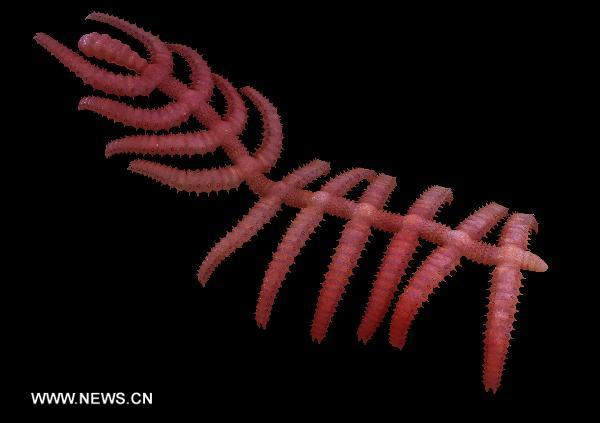 |
| This undated handout, a computer-generated image provided by Chinese scientist Liu Jianni shows the probable appearance of the remarkable 520 million year old fossil Diania cactiformis in life discovered in southwest China's Yunnan Province. The legs are partially jointed and the front of the animal, with the projecting proboscis, is to the left. The research was published on Nature Magazine on Feb. 24. (Xinhua) |
Paleontologists from Northwest University in Xi'an, capital of northwest China's Shaanxi Province, believe the animal belongs to the Lobopodia, a poorly understood, now extinct, group of animals that resembled worms with legs.
"It could be seen as a missing link from lobopodians to arthropods," said Dr. Liu Jianni who led the research.
Liu said scientists had long suspected that arthropods evolved from lobopodians, but lacked evidence to prove the hypothesis until the "walking cactus" was found.
Liu's thesis, "An armored Cambrian lobopodian from China with arthropod-like appendages," was published Thursday as the cover story on the latest issue of Nature.
The fossil, which dates from 500 million years ago, is about 6 cm long. It resembles a thin, soft-bodied worm, similar to the lobopodians. But its 10 pairs of jointed legs also resemble those of arthropods.
Liu and her colleagues believe these legs had hardened surfaces, probably similar to the tough surfaces of the articulated limbs of crustaceans or insects.
The finding could indicate that arthropods developed hardened limbs before hardened bodies, the researchers say.
Liu said the development of jointed legs was only one of the three critical steps in the evolution of arthropods from lobopodians. She and her colleagues hope to find further lobopodia fossils that show the development of both the arthropod head and jointed body.
"With these appendages, arthropods were able to run faster, jump higher and move with more agility. Some appendages even evolved into preying instruments," said Prof. Shu Degan, head of Northwest University's Early Life Institute. "They helped arthropods become powerful and eventually dominant members of marine, freshwater, land and air ecosystems."
Arthropods comprise more than 80 percent of all known living animal species, and make up the bulk of the tree of life.
Besides insects, spiders and crustaceans, arthropods also include the now-extinct trilobites. (Xinhua)
Related News
Photos
More>>trade
market
- IBCB Scientists Found the Regulatory Mechanism of a MicroRNA in Multiple
- IMP Signs MoU with Three American Labs
- Delegation Led by Minister Pinkwart from German State of North Rhine-Westfalia
- CAS Researcher Publishes Book on Marine Biogeochemistry in China Marginal Seas
- SCBG Conducts International Strategic Review and Designs for the Future





